|
|
Research Progress of Rare-earth Doped Laser Crystals in Visible Region
Na LI, Bin LIU, Jiao-Jiao SHI, Yan-Yan XUE, Heng-Yu ZHAO, Zhang-Li SHI, Wen-Tao HOU, Xiao-Dong XU, Jun Xu
2019 Vol. 34 (6): 573–589
 Abstract
Abstract(
1959 )
 HTML
HTML(
71)
 PDF
PDF(1227KB)(
2235
)
Visible laser has been widely used in data storage, optical communication, laser display, laser medical treatment, laser printing, and scientific research. With the development of commercial blue light LD, the direct pumping of rare-earth ions doped laser crystals have attracted a lot of interests. Currently, visible ions mainly concentrat on Pr 3+, Dy 3+, Tb 3+, and Sm 3+. Trivalent praseodymium (Pr 3+) is a famous rare-earth ion with extensive laser transitions in visible region such as blue, green, red and orange light. However, there is still a region in yellow emission which is not covered by Pr 3+. Dy 3+ and Tb 3+ have attracted much attention because of their yellow laser transitions. In addition, Sm 3+ and Eu 3+ are also typical visible rare-earth ions. In this paper, we mainly reviewed properties of rare-earth ions doped laser crystals for visible lasers, especially Pr 3+, Dy 3+, Tb 3+ and Sm 3+-doped YAlO3 (YAP), SrAl12O19 (SRA) crystals. A design criterion for Pr 3+ doped oxide materials was summarized. The crystal growth, structure, thermal properties, polarization spectroscopic and laser characteristics were analyzed in detail.
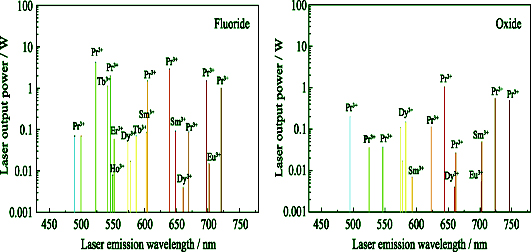
|
|
|
Nb2O5 Coating on the Performance of Flexible Dye Sensitized Solar Cell Based on TiO2 Nanoarrays/Upconversion Luminescence Composite Structure
Xi-Qing LÜ, Huan-Yu ZHANG, Rui LI, Mei ZHANG, Min GUO
2019 Vol. 34 (6): 590–598
 Abstract
Abstract(
825 )
 HTML
HTML(
20)
 PDF
PDF(3982KB)(
829
)
By using hydrothermal and spin-coating method, Ti mesh supported composite structure, TiO2 nanowire arrays/Yb-Er-F doped TiO2 upconversion luminescence nanoparticles (TNWAs/YEF-TiO2-UCNPs), was synthesized and assembled into flexible dye-sensitized solar cell (DSSC). The effect of YEF-TiO2-UCNPs optical property on the power conversion efficiency (PCE) of this device was studied. In addition, the influence of NbCl5 solution coating on morphology and performance of flexible DSSC was also investigated in detail. It is shown that the YEF-TiO2- UCNPs could expand the range of incident light utilization, in the meantime, however, increase the electron recombination in photoanode. Nb2O5 coating layer served as an energy barrier at the semiconductor/electrolyte interface, increased the composite resistance Rrec to inhibit electron recombination, improved the electron collection efficiency ηec and photogenerated electron lifetime τe, then elevated the short circuit current and the open circuit voltage, finally enhanced the performance of DSSC. The Nb2O5@TNWAs/YEF-TiO2-UCNPs composite structured DSSC achieved the best PCE of 6.89% with 20 mmol/L NbCl5 ethanol solution coating, increased 24.3% compared with the uncoated blank device.
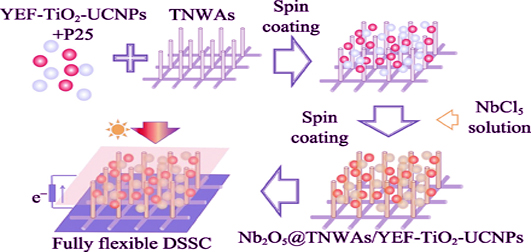
|
|
|
Near-infrared Reflective Pigments Based on Cu 2+ and Tb 3+ Codoped BaZrO3: Preparation and Performance
Shao-Dan ZHANG, Wei-Wei BAO, Hai-Ping MA
2019 Vol. 34 (6): 599–604
 Abstract
Abstract(
857 )
 HTML
HTML(
20)
 PDF
PDF(508KB)(
972
)
The urban island effect and energy crisis can be relieved usefully by environmentally benign and high near-infrared reflective pigments, which is of great significance to develop of green energy-saving industry. Ions doping is an effective way to achieve the color diversity of high near infrared reflective pigments. In this work, a series of high near-infrared reflection Ba1-xCuxZr1-yTbyO3 (x=0.15, 0.25, 0.35; y=0, 0.15) inorganic pigment co-doped with Cu 2+and rare earth Tb 3+was prepared by a Sol-Gel process. Its phase structure, ultraviolet/visible/near-infrared reflectance, and color parameters of the synthesized pigment samples were investigated and characterized by X-ray diffraction (XRD), UV/Vis/NIR spectroscopy, and color CIE-L *a *b * 1976 color scales. The results demonstrate that all synthesized pigments have cubic perovskite structure after calcined at 1100 ℃. The co-doping of Cu 2+ and Tb 3+ is successfully introduced into the BaZrO3 lattice, and the color increasingly changes from white to gray, and to yellow with the increase of Cu 2+and Tb 3+concentration. Meanwhile, the obtained pigments possess high near-infrared solar reflectance in the range of 780-2500 nm, the average reflectance is up to 80%. Therefore, these Ba1-xCuxZr1-yTbyO3 cool powdered pigment have great application prospect in the building coatings.
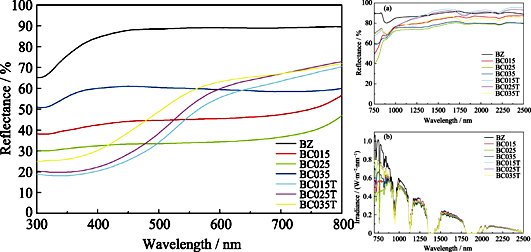
|
|
|
Al2O3 Coating Layer on the High Temperature Conductive Stability of Pt/ZnO/Al2O3 Film Electrode
Xing-Peng LIU, Bin PENG, Wan-Li ZHANG, Jun ZHU
2019 Vol. 34 (6): 605–610
 Abstract
Abstract(
500 )
 HTML
HTML(
8)
 PDF
PDF(1712KB)(
626
)
To investigate the effects of Al2O3 coating layers on the conductive stability of surface acoustic wave electrodes working at high temperature, laser molecular beam epitaxy was carried out to deposit a series of Al2O3/Pt/ZnO/Al2O3 multilayer electrodes coated with Al2O3 layers of different thicknesses. The real-time resistance measurements of these samples were performed in the heat treatment. It can be found that the conductive stabilities of Al2O3/Pt/ZnO/Al2O3 samples were significantly related to the thickness of the Al2O3 coating layers. For the sample without Al2O3 coating layer, its resistance began to increase when the temperature rose up to 800 ℃. However, its resistances began to increase at 900, 1100 and 1150 ℃, at the thickness of Al2O3 coating layers of 40, 80 and 120 nm respectively. For the samples with 160 nm and 200 nm Al2O3 coating layers, the resistances almost remained stable during the whole heating process. According to the surface topographies of these samples, it found that the sample without Al2O3 coating layer formed isolated Pt grains after high-temperature measurement. As a comparison, the samples with Al2O3 coating layers did not form isolated Pt grains after high-temperature resistance measurement. After high-temperature measurement, the less discontinuous Pt voids appeared at the surface of the sample with a relative thicker Al2O3 coating layer. XRD tests of theses samples, performed before and after high-temperature measurement, showed that Pt recrystallization at high temperature can be inhibited by the Al2O3 coating layer, and the thicker layer could inhibit its recrystallization more effectively. These results provide a new way to prepare SAW devices which can work stably at high temperature.
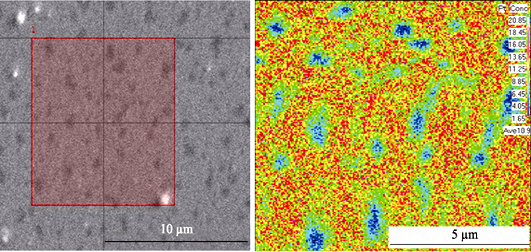
|
|
|
Structural Stability of Ni-Fe Supported Solid Oxide Fuel Cells Based on Stress Analysis
Kai LI, Xiao LI, Jian LI, Jia-Miao XIE
2019 Vol. 34 (6): 611–617
 Abstract
Abstract(
740 )
 HTML
HTML(
28)
 PDF
PDF(7397KB)(
971
)
Metal supported solid oxide fuel cells (MS-SOFCs) were fabricated with NiO and Fe2O3 by tape casting, screen printing, sintering and in-situ reducing process with NiO and Fe2O3. The fraction effects of Fe on residual stress, bending strength and electrochemical stability of MS-SOFC were systematically investigated. The addition of 10at% Fe2O3 in characteristic support elevated densification starting temperature up to 937 ℃, and reduced residual stress and buckling deformation to 70 MPa and 0.15 mm, respectively. After reduction, Ni0.9Fe0.1supported SOFC presented the maximum bending strength of 62.34 MPa due to the lowest porosity of 40.22% in metal scaffold. MS-SOFC steadily operated for 60 h in durability test with H2 as the fuel at a constant current density of 400 mA·cm -2 and 650 ℃. This superior performance was attributed to the higher fracture strength of Ni0.9Fe0.1 alloy support SOFC, which effectively resisted the thermal stress in operation. This research provides a promising theoretical basis for structure design and optimization of MS-SOFC.
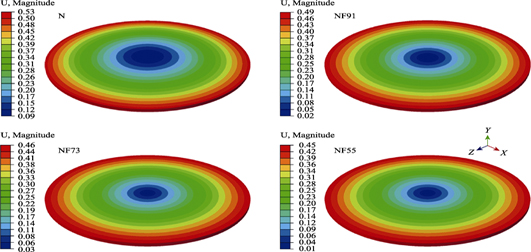
|
|
|
Morphology Controlling of the High-voltage Cathode Materials with Different Co-solvents
Jian-Huang KE, Kai XIE, Yu HAN, Wei-Wei SUN, Shi-Qiang LUO, Jin-Feng LIU
2019 Vol. 34 (6): 618–624
 Abstract
Abstract(
679 )
 HTML
HTML(
11)
 PDF
PDF(3160KB)(
829
)
Cathode material LiCoPO4 was synthesized by solvothermal method with a variety of water/alcohol solvent mixtures, including ethanol (ET), ethylene glycol (EG), and diethylene glycol (DEG). Focus of this work was set on the effect of the different alcohol solvent on morphology and particle size of material. Composition, crystal structure, morphology and particle size of the as-prepared samples were characterized by X-ray-diffraction, scanning electron microscopy and specific surface area test. The results show that relationship of the average particle size of the LiCoPO4 samples synthesized with different alcohols solvents is in agreement with solubility of solvent for the precursor, but is inconsistent with the viscosity of solvent. Furthermore, LiCoPO4 sample synthesized with EG/H2O possesses the smallest particle size, great crystallinity and excellent cycle performance. Its initial discharge specific capacities reaches to 130 mAh/g at 0.05C, and it shows a capacity retention of the initial value of 88% in 20th cycle. A variety of shapes are obtained from various co-solvents: hexagonal platelets for LiCoPO4 obtained from EG, whereas, square platelets for LiCoPO4 from ET/H2O and DEG/H2O.
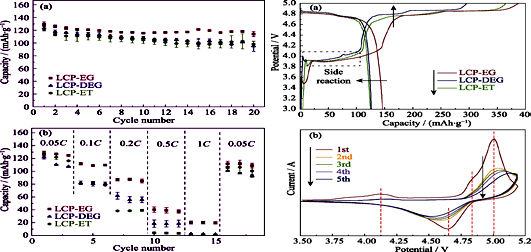
|
|
|
Preparation of Cork-derived Porous Activated Carbon for High Performance Supercapacitors
Wei-Jia XU, Da-Ping QIU, Shi-Qiang LIU, Min LI, Ru YANG
2019 Vol. 34 (6): 625–632
 Abstract
Abstract(
860 )
 HTML
HTML(
18)
 PDF
PDF(1806KB)(
895
)
The quercus variabilis cork made up of cavity cells is used as raw material. Herein, the cork-derived activated carbon with the various pores was successfully prepared by the facile carbonization of cork followed by chemical activation. The as-prepared activated carbon sheets possess large specific surface area (2312 m 2/g) and unique interconnected pores. As a result, it shows excellent electrochemical performance as electrode material for supercapacitors. In three electrode system of KOH, it exhibits a high specific capacitance of 296 F/g at a current density of 0.1 A/g. The assembled symmetric supercapacitor shows a high specific capacitance of 201 F/g at 5 A/g, with a good cycling stability of 99.5 % capacitance retention after 5000 cycles. In two electrode system of Na2SO4, the symmetric supercapacitor displays a good rate performance of 80.5% retention from 0.5 A/g (174 F/g) to 50 A/g (140 F/g) and a high energy density of 19.62 Wh/kg.
|
|
|
A New Polyethylene Composite Material Based on Nano Silver Particels Loaded Graphene Oxide
Feng ZHANG, Kai-Li ZHANG, Ming-Ming ZHOU, Chao CHEN, Zhi-Wei CAI, Guo-Hui WEI, Xing-Mao JIANG, Cheng ZHANG, RUHLMANN Laurent, Yao-Kang LÜ
2019 Vol. 34 (6): 633–640
 Abstract
Abstract(
738 )
 HTML
HTML(
16)
 PDF
PDF(8306KB)(
1200
)
A new nano silver particels loaded graphene oxide (AgNPs@GO) was obtained through ultrasonic assisted liquid phase method. In AgNPs@GO, nano silver particels (AgNPs) are mainly anchored at oxygen containing groups and defects of graphene oxide (GO) sheets, part of GO sheets are reduced and some Ag(0) atoms have been oxidized to Ag + ions. AgNPs@GO exhibits significantly stronger ability for inhibiting Pseudomonas aeruginosa than that of AgNPs and GO. Therefore, AgNPs@GO was further introduced to polyethylene (PE) matrix as an additive to prepare a new composite material 0.48wt%-AgNPs@GO/PE. Compare with bare PE and AgNPs doped PE composites, 0.48wt%-AgNPs@GO/PE not only has a better antibacterial ability and stronger water vapor barrier property, but also dissolves out less nonvolatile substance than PE in water and ethanol solution.
|
|
|
Preparation of Fully-coated Ag@TiO2 Particle Fillers for High-k Composites
Gang JIAN, Mei-Rui LIU, Chen ZHANG, Hui SHAO
2019 Vol. 34 (6): 641–645
 Abstract
Abstract(
529 )
 HTML
HTML(
12)
 PDF
PDF(1628KB)(
677
)
High-k composites have been actively pursued in the past few years for potential applications in embedded capacitors and energy-storage devices. In this study, Ag@TiO2 core@shell particles were synthesized by a hydrolysis from titanate alkoxides at room temperature. Composites filled with the particle fillers were characterized for I/V, dielectric and energy-storage characteristics. Mechanisms of influences of Ag@TiO2 fillers on dielectric properties of composites were investigated. Scanning electron microscopy and energy dispersive spectra exhibit that the synthesized Ag@TiO2 particles have spherical and fully-coated core@shell structures. X-ray diffraction pattern confirms the phase of Ag and TiO2 in the particles. The polydimethylsiloxane composites filled with Ag@TiO2 fillers exhibit a small leakage current of 10 -8A/cm 2, a high dielectric permittivity of 108, and a very low dielectric loss of 0.2%, and a large energy storage density of 8.58×10 -3J/cm 3. Theoretical model containing effective medium theory (EMT) and Maxwell theory were used to compare with experimental results, and interfacial polarizations were proposed to enhance the permittivities of the composites. The composites filled with Ag@TiO2 fillers show potential applications in the embedded capacitors.
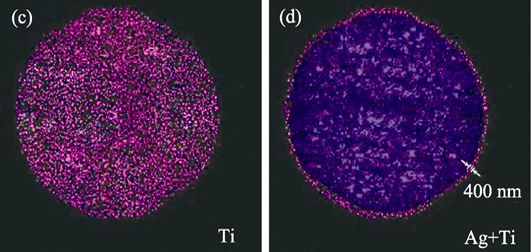
|
|
|
Microstructure and Property of MoSi2-30Al2O3 Electrothermal Coating Prepared by Atmospheric Plasma Spraying
Yan-Zhe ZHOU, Min LIU, Kun YANG, Wei ZENG, Jin-Bing SONG, Chun-Ming DENG, Chang-Guang DENG
2019 Vol. 34 (6): 646–652
 Abstract
Abstract(
535 )
 HTML
HTML(
11)
 PDF
PDF(1673KB)(
766
)
With MoSi2-30Al2O3 mixed powders as the raw material, MoSi2-30Al2O3 electrothermal coating was sprayed by atmospheric plasma spraying technology. The phase composition, microstructure and thermal stability of the coating were systematically studied by XRD, SEM, electrical test and differential thermal gravity analysis. The results show that MoSi2-30Al2O3 electrothermal coating shows dense microstructure. Al2O3 can improve the electrical resistivity and oxidation resistance of MoSi2 materials in low temperature. The coating exhibits an excellent electrical-heating performance. In the heating cycle test, it could be heated to 320 ℃ stably and exhibit uniform thermal distribution in the surface area. The temperature variation in roll’s central area can be controlled within 25 ℃; Oxidation and thermal stress relaxation during heating cycle would generate cracks and pores in the coating which would increase electrical resistivity.
|
|
|
B2O3-SiO2-Na2O Controlled-release Material: Synthetic Parameters Optimization and Release Mechanisms Exploration
Chang-Xing HUANG, Jun CUI, Yuan-Sheng PEI
2019 Vol. 34 (6): 653–659
 Abstract
Abstract(
489 )
 HTML
HTML(
4)
 PDF
PDF(573KB)(
735
)
Aiming at optimization of synthetic process, reduction of raw materials loss and control of production cost, the single factor method was used to study the effects of different heating rate, holding time, melting temperature, and initial temperature on the B2O3 volatilization and bubble formation during the preparation of borate controlled- release material (BCRM). The physicochemical properties of BCRM before and after controlled-release were characterized by X-ray diffraction analysis, infrared spectroscopy and X-ray photoelectron spectroscopy, and the release mechanism of BCRM was analyzed by Korsmeyer-Peppas model. The results show that the amount of B2O3 volatilization can be reduced to 1.08%, no bubble forms in the transparent BCRM, and controlled-release performance is acceptable under optimum conditions of initial temperature 1050 ℃, holding time 2 h and melting temperature 1050 ℃. Controlled-release mechanism of BCRM, affected by temperature, is Super Case II transport at 30 and 35 ℃ while it is non-Fickian diffusion at 40 ℃. However, the cumulative release rate of boron is greater than 95% at different temperatures.
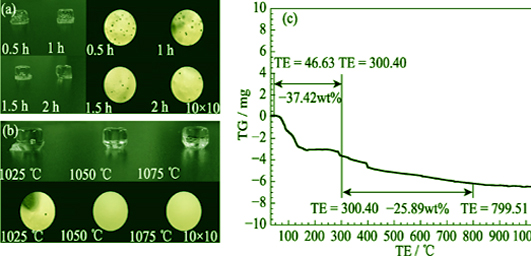
|
|
|
Simulation of ZrB2 Oxidation Behavior at Constant Temperature Ambient
Shu-Guang ZHOU, Yi-Jun GUO, Xiao LIU
2019 Vol. 34 (6): 660–666
 Abstract
Abstract(
578 )
 HTML
HTML(
7)
 PDF
PDF(864KB)(
639
)
Zirconium diboride (ZrB2), a thermal protection material for hypersonic vehicle, has received widespread attention in recent years. Here we advance an oxidation model based on oxidation products (ZrO2 and B2O3) and their morphology at different temperatures to simulate the oxidation behavior of ZrB2. This study further establishes the dynamic equilibrium among formation, evaporation and supplement of B2O3 whose concentration at ambient was assumed to be nonzero. Research results indicate that the advanced model can predict the oxidation behavior of ZrB2 under quasi-static low flow conditions and the simulation results are consistent with the data obtained from sample suspended in wire heater furnace at constant temperature. The porosity has a great influence on the oxidation process, and at the same temperature and oxygen partial pressure, the larger the porosity, the higher the oxidation degree. The oxidation rate controlled by diffusion in the presence of liquid B2O3 film laying outer surface of substrate reduces greatly and the material exhibits the strongest oxidation resistance.
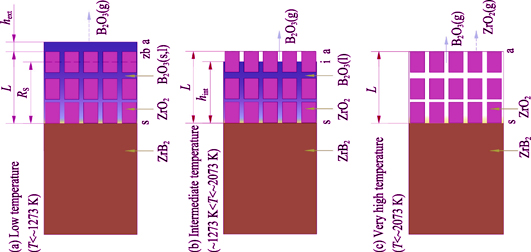
|
|
|
Mass Production of α-silicon Nitride Single-crystalline Nanowires
Chao LEI, Fei WEI
2019 Vol. 34 (6): 667–672
 Abstract
Abstract(
634 )
 HTML
HTML(
12)
 PDF
PDF(2325KB)(
768
)
α-silicon nitride single-crystalline nanowires were prepared by direct nitridation of granulation Si powders in N2-H2 mixture gas. The nitridation product has the core-shell structure (Si3N4 nanowires @porous Si3N4 powders), where Si3N4 nanowires can be effectively separated by crushing and grinding. The results show that the as-prepared α-Si3N4 nanowires are straight and uniform with diameters of 80-150 nm, length to diameter ratios of 20-50, purity higher than 95wt%, and yield of 3.1%. Further study indicates that growth of Si3N4 nanowires is controlled by the Vapor-Liquid-Solid (VLS) mechanism, where the trace Fe elements serves as catalyst in the reduction atmosphere. In this study, The process of the raw silicom powder granulation after nitriding shows three advantages: 1) remarkably increasing growth space of nanowires; 2) leading to concentrated distribution of nanowire, tacilitating subsequent separation; 3) remarkably increasing the nitridation rate.
|
|
|
Friction-wear Properties and Mechanism of Hard Facing Pairs of SiC and WC
Xiu-Min YAO, Xiao-Jie WANG, Xue-Jian LIU, Zhong-Ming CHEN, Zheng-Ren HUANG
2019 Vol. 34 (6): 673–678
 Abstract
Abstract(
931 )
 HTML
HTML(
21)
 PDF
PDF(3549KB)(
843
)
Sliding friction-wear properties of pressurelessly solid-state-sintered silicon carbide ceramics (SSiC) and liquid-phase-sintered SiC ceramics (LPSiC) pairing with tungsten carbide (WC) were researched under the frictions with or without lubrication. Under dry friction, as compared to LPSiC/WC pairs, SSiC/WC pairs have higher friction coefficient (μ) and less mass loss (Δm) due to SSiC ceramics have larger particle size and higher hardness. The surface topography of worn area was detected by SEM companying with elements mapping and micro-area XRD technology. The micro plough cut and micro fracture led to the wear of SiC ceramics. Its fatigue damage led to the wear of WC materials. The grinding-out WC grains were oxidized to amorphous WO3 phase due to the friction heat generated in the friction. Under the wet friction with water as lubrication, as compared to SSiC/WC pairs, LPSiC/WC pairs have higher friction coefficient and less mass losses. Whether under dry friction or wet friction, the pairs with SiC ceramics as the fixed materials have lower μ and Δm than those with SiC ceramics as the rotated materials.
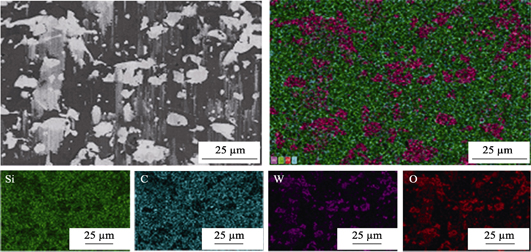
|
|
|
Fabrication and Planar Cooling Performance of Flexible Bi0.5Sb1.5Te3/epoxy Composite Thermoelectric Films
Peng LI, Xiao-Lei NIE, Ye TIAN, Wen-Bing FANG, Ping WEI, Wan-Ting ZHU, Zhi-Gang SUN, Qing-Jie ZHANG, Wen-Yu ZHAO
2019 Vol. 34 (6): 679–684
 Abstract
Abstract(
697 )
 HTML
HTML(
20)
 PDF
PDF(3497KB)(
918
)
Flexible Bi0.5Sb1.5Te3/epoxy composite thermoelectric films were prepared on polyimide substrates by screen printing. Its electrical transport properties are enhanced by optimizing the content of Bi0.5Sb1.5Te3 powder. The highest power factor of the optimized Bi0.5Sb1.5Te3/epoxy films reached 1.12 mW·m -1·K -2at 300 K, increased by 33% as compared with previous value. The anti-bending test results show that resistance of the thick films remains unchanged when the bending radius is over 20 mm and slightly increases within 3000 bending cycles when the bending radius is 20 mm, implying that the as-prepared films have potential application in flexible TE devices. The flexible thermoelectric leg could establish a temperature difference from 4.2 ℃ to 7.8 ℃ under working current from 0.01 A to 0.05 A, showing potential application in planar cooling field.
|
|